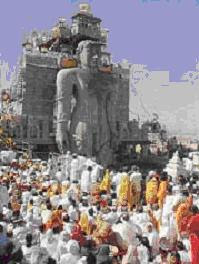· Hastinapur, holy destination comprising of a collection of temples and pilgrimage locations
· Shikharji, also known as Parshvanathji or Sammet Sikhar and located in Giridih district in Jharkhand state, is considered the most sacred pilgrimage site. Parshvanath Hill is about 4481 feet high, and twenty Tirthankars attained Nirvan here.

Figure 14: Shikarji
Parasnath hill which is 4431 ft height is the highest mountain south of the Himalayas. It is located at the latitude of 23 degree ,9 minutes North and longitude of 86 degree ,3 minutes East. It was made accessible since the construction of a road in 1838 .Significantly the oldest of the jain temple appears to date only from AD. 1775.
· Shravanabelagola, a monumental statue of Saint Gomateshwar in Hassan District, Karnatak.

Figure 15: Shravanabelagola
Shravanabelagola is a city located in the Hassan district, Karnataka, India. It is one of the most important Jain pilgrim centers. In Kannada language, "Bel" means white and "kola", the pond, an allusion to the beautiful pond in the middle of the town. It reached a high point in architectural and sculptural activity under the patronage of Gangas of Talakad.
· Dilwada Temples, complex of white marble Jain temples on Mount Abu, Rajasthan.

Figure 16: Dilwara
The Jain Dilwara temples of India are located about two kilometers from Mount Abu, Rajasthan's only hill station. These temples built between the 11th and 13th centuries AD are world famous for their stunning use of marble. The five legendary marble temples of Dilwara are a sacred pilgrimage place of the Jains. Some consider them to be one of the most beautiful Jain pilgrimage sites in the world. The marble temples have an opulent entranceway. The simplicity in architecture may remind one that Jainism has always encouraged honesty and frugality. The temples are in the midst of a range of forested hills. A high wall shrouds the temple complex.Although the Jains built some beautiful temples at other places in Rajasthan, some believe that none come close to these in terms of architectural perfection. The ornamental detail spreading over the minutely carved ceilings, doorways, pillars and panels is simply marvelous.
· Palitana, most visited Jain temple in Gujarat.

Figure 17: Palitana
The Palitana temples are considered the most sacred pilgrimage place (tirtha) by the Jain community. There are a total of 1250 temples located on the Shatrunjaya hills, exquisitely carved in marble. The main temple on top of the hill is dedicated to 1st tirthankar lord Adinath (Rishabdeva).
· Girnar, a temple in Gujrat.
· Vataman, (between Ahmedabad and Palitana) with a beautiful Adinath derasar
· Bawangaja, a complex of Jain temples and monumental statues in Barwani District, Madhya Pradesh.
· Gwalior's fort is home to dozens of Jain rock-cut sculptures.
· Sonagir, about 60 km from Gwalior, has scores of temples on little hills.
· Bajrangadh, Atisaya-kshetra in Guna district in Madhya Pradesh, India
· Ranakpur Temples, extensive complex of white marble Jain temples in Ranakpur, Rajasthan.
· Nakoda Parsvanatha Jain temple is a holy place of the Jains near Barmer, Rajasthan
· Kundalpur, Siddha-kshetra with 63 temples, is famous for a beautiful statue of Bade Baba in Damoh district in Madhya Pradesh, India

Figure 18: Kundalpur
Kundalpur is a historical site in India. It is located in central Bihar, 1.6 km from the ruins of Nalanda.The Digambar sect of the Jains believes that Kundalpur ihar is the birthplace of the 24th and last Tirthankar, Lord Mahavira.
· Shri Mahavirji/Chandanpur, in Sawai Madhopur district in Rajasthan, India has a 78 cm high copper-colored idol of Mahavir in the Padmasana posture. It is the most visited temple in Rajasthan.
· Tijara/Dehra, Atisaya-kshetra, in Alwar district in Rajasthan, India, where the principal Tirthankar is Chandraprabhu
· Ananthanatha Swami Temple (also known as the Puliyarmala Jain Temple} in Puliyarmala, outside of Kalpetta in Wayanad district, Kerala.
· Nageshwar Parshavanath Tirth Near Ratlam MadhyaPradesh has a very big idol of Parshavanath.
· Mohankheda Tirth Near Jhabua MadhyaPradesh is very famous. It is the Swargarohan Place of Rajenedrasuri Maharaj.
· Rajgir Jain Temple has a ancient History from period of Ramayana & Buddha

Figure 19: Rajgir
Rajgir (Rajgrahi) is the famous pilgrimage centre for Jains, this is also known as Panch Pahadi. Rajgir is famous as Jain Teerth from ancient times. Twentieth Teerthankar Muni Suvratnath's four Kalyanka - Garbha, Janma, Tapa and Gyan (Jnan) were celebrated at this sacred place. This place was capital of King Jarasandha (Contemporary to Lord Krishna) nd capital of the emperor of Magadha King Shrenik (Bimbsar). King Shrenik was the principal disciple of Lord Mahavir. Rajgrahi had the great strategic importance also at that time.














